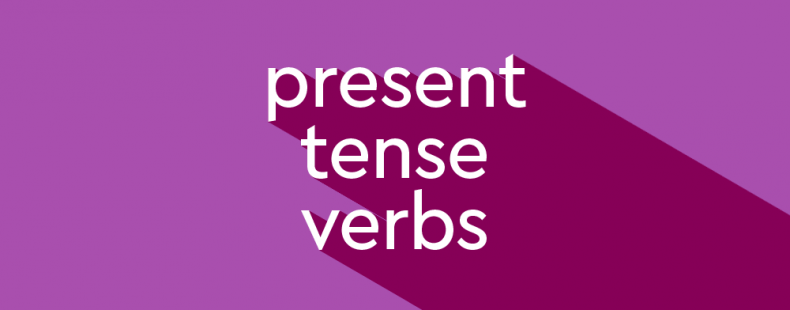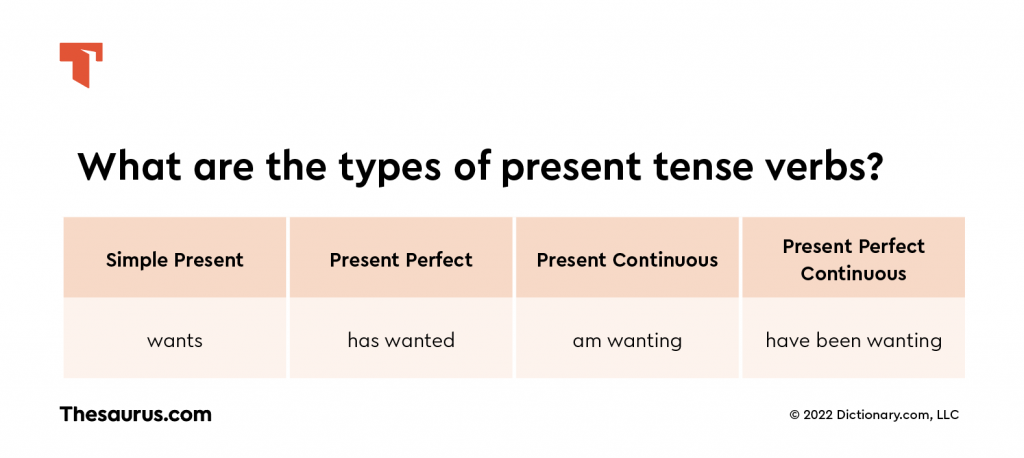Take a quick moment to think about all of the things that are happening around you right now. If you’re inside, maybe a radio is playing music. Or maybe someone has been mowing their lawn for the past couple of hours. If you’re outside, you might see a car drive by. Or maybe some people on the street have walked past you.
Regardless of what is going on, we can use words called verbs to refer to all of the actions and states we see happening around us. We actually use four different types of verb tenses to say something about the present.
So, let’s not waste any more time and learn more about the group we call present tense verbs right now!
What is a present tense verb?
Generally speaking, we use present tense verbs to say that an action or state happens in the current moment. However, because grammar can never make things easy on us, present tense verbs don’t always talk about the present. Sometimes, we can even use types of present tense to say that something also happened in the past or may even happen in the future.
Verbs are used in the present tense for many different reasons. Some of these reasons include:
- Describing events or states that are happening in the present (right now)
- Saying that events or states happen regularly or routinely
- Stating facts, beliefs, or opinions
- Describing events or states that began in the past and continue into the present
- Referring to events or states that are in progress in the present and will continue into the future
- Stating that an event or state is planned to happen in the future
- Saying that something is currently in progress
- Stating that something began a while ago but still continues to happen at the current time
The four types of present tense verbs
In English, we use four different types of present tenses. Here we provide names and examples of each of the types of present tense.
Simple present tense:
- The cat hates me.
- They want cake.
- She exercises every day.
Present perfect tense:
- He has cooked bacon three times today.
- The dogs have chased their tails for hours.
- I have seen this movie before.
Present continuous tense:
- I am waiting for the mail.
- He is living life to the fullest.
- She is looking for a roommate.
Present perfect continuous tense:
- I have been coughing all morning.
- Jasmine has been texting for hours.
- Billy has been studying biology since he was a kid.
Simple present tense
The simple present tense uses the root form of the verb except when the subject is in the third person. The simple present tense has several different uses:
Actions/states occurring in the present:
- James lifts weights while Heather uses the treadmill.
- This fish smells like an old boot.
Actions/states that happen regularly:
- I read books every night.
- He is always angry.
Stating facts:
- Dogs are mammals.
- LeBron James plays basketball.
Expressing opinions or beliefs:
- My dad is a cool dude.
- Kittens are really cute.
It all starts with the simplest of them all, the simple present. Learn more about it here.
Present perfect tense
The present perfect tense uses the verb have or has with the past participle of the verb (for regular verbs, ending in -ed, -d, or -t). This tense is used to describe actions or states that connect the past to the present. For example:
- She has slept all day. (She was sleeping in the past and she is still sleeping now)
- We have read every book in this library. (We are currently standing in the same library that houses the books we read in the past)
- You have asked me that same question 10 times already. (You are asking me the same question now that you asked repeatedly in the past)
Present continuous tense
The present continuous tense uses present tense forms of the verb be with the present participle of the verb (ending in –ing). This tense also has a few different uses:
Actions happening now that will continue in the future:
- I am working on my masterpiece.
- Her annoying cat is yowling loudly.
Actions that are planned for the future:
- I am going to Denmark next week.
- My friends are coming to my house tonight.
Present perfect continuous tense
The present perfect continuous tense uses the phrase have/has been followed by the present participle of the verb (ending in –ing). This tense is used to indicate that an action began in the past, has continued to happen up until the current moment, and will likely continue to happen into the future. Here are examples of sentences that use the present perfect continuous tense:
- I have been playing the piano since I was a little kid.
- Haruto has been living in Tokyo for seven years.
- Patrick and Bob have been raking leaves all morning.
No time like the present to improve your writing!
You won’t mistake your verb tenses again when you check your writing on Thesaurus.com’s Grammar Coach™. This writing tool uses machine learning technology uniquely designed to catch grammar and spelling errors. Its Synonym Swap will find the best nouns, adjectives, and more to help say what you really mean, guiding you toward clearer, stronger, writing.
Whether you’re writing about the past, present, or future, start writing smarter today!
















